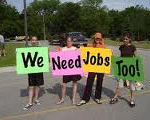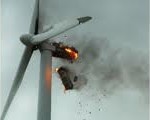
by | Aug 16, 2012
 The following is an interesting study released recently, and the reaction by the GOP (written up by Jill J.).
The following is an interesting study released recently, and the reaction by the GOP (written up by Jill J.).
In a policy study released by the Public Interest Institute at Iowa Wesleyan College, author Amy Frantz analyzed Iowa’s teen unemployment situation. The report notes Iowa’s unemployment rate for teens has remained consistently high over recent history. Two subgroups are analyzed within the data: teens ages 16-19 and high school graduates 18-20 years old.
The report notes that the unemployment rate for the 16-19 year old group was at a very high 12.3 % in 2002 and over the course of the last decade has remained at the high level, with the most recent report for 2011 showing that the unemployment rate for 16-19 year olds was 13.8%. This is much higher than the overall unemployment rate in Iowa which was just below 6% in 2011. Similarly, the 18-20 year old high school graduate group’s unemployment rate was 9.6% in 2002 and has risen higher, peaking in 2010 with a rate of 19.3% before coming down below 18% in 2011.
Not only are the unemployment rates higher, but an analysis of the number of hours worked for these two groups has seen a reduction in the last decade as well. The average number of hours worked per week for the 16-19 year olds in 2002 was 12.5 hours, but has dropped to 8.1 hours per week in 2011. Again, the 18-20 year old high school graduates faced a similar situation wherein their average hours worked in 2002 was 21.1 per week, falling to 16.7 hours per week in 2011.
The study references the rise in minimum wage as one of the driving forces behind the tremendously high teen unemployment rate. Iowa’s minimum wage was raised by the Iowa Legislature and Governor Culver in 2007 from $5.15 per hour to $6.20 per hour, and then in 2008 it was raised to $7.25. The federal minimum wage was also raised by the Democratically-controlled Congress, up to its current level of $7.25 an hour, matching Iowa’s rate. The study links this rise of the minimum wage to the increase in teen unemployment rate, noting that “teenagers are five times more likely to earn the minimum wage than adults. Thus the impact of an increase in the minimum wage would be felt dramatically by that segment of the workforce.†Those most hurt by a rise in minimum wage are often the youngest and most unskilled workers as businesses cannot afford to pay increased wages for individuals that might not have the necessary training or productivity to bring to the business.
Lastly, the study proposes an idea on how to lower the teen unemployment rate in Iowa. The study proposes to create a “sub-minimum†wage for teen workers in the state, which would allow businesses to pay certain teens an amount below the minimum wage that would apply to all other workers. The study concludes with the observation that “The benefit of having a higher minimum wage is cancelled out if teen workers are receiving fewer hours of work. And for those teens that want a job but cannot find one, their wages are $0.â€

by Steven Waechter | Mar 7, 2012
 I recently heard a radio commercial urging me to contact various members of Congress to voice my support for tax credits connected to the wind energy industry. On a lark, I went to the Iowa Legislature website and searched active bills for the word “wind,†and received several dozen hits, many of which seemed to be focused on state tax credits for manufacturing and installing wind turbines. Both state and federal politicians seem to be tripping over themselves to get into the wind energy craze.
I recently heard a radio commercial urging me to contact various members of Congress to voice my support for tax credits connected to the wind energy industry. On a lark, I went to the Iowa Legislature website and searched active bills for the word “wind,†and received several dozen hits, many of which seemed to be focused on state tax credits for manufacturing and installing wind turbines. Both state and federal politicians seem to be tripping over themselves to get into the wind energy craze.
Back in 2010 Alliant Energy was petitioning to be allowed to increase the rates they charged for electricity, and one of the supporting reasons they put forward was the $150 million project called the Whispering Willow-East wind farm in Franklin county. This was big news in Newton, where I was living at the time, as Newton is both the location of some wind turbine manufacturers, and within the area that would be affected by the rate increase.
This serves as perhaps a perfect litmus test for how people think about economics. If you are a progressive or a neo-Keynesian, then your reaction is likely to be that this is entirely appropriate; these wind farms are being built for our benefit, so of course we must pay. If you are an environmentalist or a socialist, then, of course electricity should cost more in your mind. As you are increasing your standard of living, at the unfair expense of the environment or the proletariat, it would be akin to questioning whether people should be locked up for committing assault, wouldn’t it?
If you believe in Austrian economics, or just in free-market pricing in general, then this situation would seem a bit odd. The supply of electricity is presumably increasing because of new wind farms. Increases in supply tend to reduce pressure on prices, not cause them to increase. Yet here, the new wind projects are being cited as a reason to increase the rates per kilowatt hour to the end users. They have built a wind farm, and now demand to pay for it by charging more for electricity still produced mainly by coal which could have been provided for the old price if they hadn‘t bothered to build the wind farm.
That is how capital investment works; if you couldn’t make money by building houses in the current market, but you build a bunch of houses anyway, it doesn’t cause the price of houses to go up. Wind energy doesn’t seem to follow the script of wealth creation.
The rule of thumb seems to be that a wind turbine costs about $1 million per nameplate megawatt of capacity, so if a turbine has 3 megawatts of stated capacity then it would cost about $3 million. Then you have to factor in what the industry refers to as the “capacity factor,†which is the percentage of the nameplate capacity that the turbine actually produces, and in Iowa the capacity factor is said to be about thirty percent. In plain terms, that means that if you want one megawatt of electricity, you need a three-megawatt wind turbine. However, it isn’t as simple as that. Although Iowa might be the “Saudi Arabia of Wind†– proclaimed as such by people who have likely never been to Saudi Arabia, nor had difficulty paying their electric bills – our winds are not constant.
When the wind doesn’t blow, the turbines don’t turn. The same is true for when the wind is too strong – wind turbines are equipped with a braking mechanism to stop them during high winds. If that brake fails, the turbine blades can rattle the entire tower to pieces, if the generator doesn’t catch on fire first – which you should look up on the internet because it is an interesting sight.
As a result of all the shortcomings of wind turbines, wind power costs about $90 per megawatt hour, compared to about $60 per megawatt hour for coal and even less than that for natural gas-generated electricity, yet we are told we need to fill our skylines with expensive wind turbines which spend most of their lives perfectly still and producing nothing – and then charge us for the cost of the electricity these intensely ugly things don’t produce. The Iowa Wind Energy Association has a goal to increase Iowa’s wind capacity from 4,500 megawatts to 20,000 megawatts by 2030 – so we can enjoy 6,000 megawatts of electricity doled out in intermittent intervals.
Germany announced its intent to decommission all of its nuclear power stations after the Fukushima incident, and the German government has been very supportive of wind energy, but not a single coal plant has been shut down. In fact, Germany is replacing its nuclear capacity with new coal power plants – as many as 26 new coal power plants are planned. The wind, like the sea, is a fickle lover as it would seem.
According to wind energy supporters, expanding wind energy creates jobs, and therefore none of the shortcomings in the technology or the economics are considered to matter. This attitude seems to be the source of the consensus among political leaders – or at least the appearance of consensus – as politicians go along with the wind energy movement lest they be accused of being “against jobs.†There are even pictures of wind turbines on Iowa’s new driver’s license design.
The wind energy addiction will end up being much the same as the other fads. State and federal tax credits, grants, and green energy targets are directing capital towards these wind energy projects. The jobs created in the short term are visible to politicians seeking reelection, but the damage is diffused across the entire economy and the effects won’t be felt until later. They can see the turbine blades going down the interstate, but not the higher utility bills of their constituents – including employers – nor the layoffs when the negative financial effects become impossible to ignore. Americans are too broke to pay for expensive wind-generated electricity, governments are too broke to continue subsidizing these projects, and the economy is too broke to carry an industrial sector which generates no profits, no useable increases in electricity, and no discernable tax revenue.
Wind turbines don’t increase the standard of living; in fact they seem to make energy more expensive. They only work intermittently, wear out rather quickly without expensive maintenance, and are heavily dependent on government credits and grants for their manufacture and installation. They have also been known to kill eagles, which is reason enough to hate anything.
The future might be filled with wind turbines, but that won’t be a positive thing. They are too expensive and too underproductive to provide electricity in quantities and at prices that are necessary to make them profitable. Elected officials at all levels need to move past the rhetoric of the wind energy craze and do their own research into this matter.
Unless they do so, they have no business voting to appropriate public funds to support the construction of more public relations kitsch at $1 million per nameplate megawatt. Even now attention is turning towards natural gas as the real driver of future energy production while a combination of better exploration techniques and hydraulic fracturing makes natural gas properly cheap.
Alliant itself is looking at building a new natural gas power plant – in Iowa.

by | Mar 2, 2012
 The year was 2010. In Iowa, like in the rest of the Country, a reaction to the obscene growth in size and spending at all levels of government boiled into a loud and visible public movement. The internet was a buzz, local Tea Party chapters were springing up, and the Iowa Capitol was the site of several well attended rallies expressing the sentiment of less government and lower taxes. Two years later, it is time to ask the question—what results have come of this?
The year was 2010. In Iowa, like in the rest of the Country, a reaction to the obscene growth in size and spending at all levels of government boiled into a loud and visible public movement. The internet was a buzz, local Tea Party chapters were springing up, and the Iowa Capitol was the site of several well attended rallies expressing the sentiment of less government and lower taxes. Two years later, it is time to ask the question—what results have come of this?
The short answer at the state level here in Iowa is—not too much so far.
Most will argue that more patience is required—and they are right. Many will cite a variety of reasons that explain the lack of great action—some valid points to be sure. Meanwhile, the more optimistic in the movement will point to some victories—and I grant that they have a case.
All this considered, it is hard not to be disappointed with the lack of impact Tea Party ideals have had on Iowa’s legislative process. Let’s take a brief look at the landscape.
Victories So FarÂ
Probably the biggest achievement Republicans at the State House can point to is drastically slowing the pace of growth in the annual budget. It would likely shock most Iowans to know that the total appropriations made by our legislature in the year 2002 was $4.375 billion dollars, less than a decade later (FY 2011) the amount spent had jumped to $5.8 billion, an indefensible increase of 33% in less than a decade. Though slightly more money has been spent in each of the last few years, getting a handle on this expansion was not necessarily a given, and for this kudos are well deserved.
The problem here of course is baseline budgeting. The ridiculous increases seen from 2002-2011 have now been built into future budgets—with next year’s expenditure and all projected future years being amounts in excess of $6 billion per year. The reality is that Iowans, of either political party, who are holding their breath for a significant decrease in their taxes can expect two things—a blue-ish hue followed by a funeral. The simple fact is that while future tax hikes can be avoided, as long as the legislature is spending over $6 billion a year—your taxes are not significantly going down.
Other victories that can be pointed to will be met by fiscal purists with justifiable skepticism, the formation of the Property Tax Relief Fund and 0% allowable growth for education in 2012. Time will tell, but the Property Tax Relief Fund may end up being yet another technocratic “victory†in the legislative shell game. I may be wrong, but I can tell you from experience that digging down into the details of many proposed reforms and tax cuts often end up being more of an exercise in moving money around than anything else. In terms of the achievement of 0% allowable growth, this was gained in exchange for 2% growth in 2013 and could be completely erased if an already proposed 4% growth rate in 2014 is green lighted. For the record, approving a 4% increase in education spending would directly cost taxpayers another $196.2 million.
The Reasons
There are many factors that account for this lack of action, and they make it blatantly unfair to directly blame our fiscally Conservative legislators for not achieving sweeping change.
Chief among these is the narrow, but iron fisted, control spend-happy Democrats have in the Iowa Senate. Pragmatically speaking, one could argue it doesn’t make much sense to propose large initiatives that are effectively dead on arrival in the Senate. In addition to this it is hard to get movement in these areas when one of the major players, the governor, is not fully on board. Let’s face it, while he is undoubtedly a strong Republican—he isn’t exactly going to be caffeinating any bodies of water under the cover of darkness any time soon.
Realistically the most valid reason is the predetermined circumstances surrounding this session. All the oxygen is being consumed by the massively involved efforts left over from last session, which include preventing built-in tax increases, re-structuring mental health services, and a flailing attempt at education reform. A final thing that deserves mention is that they have been put on defense by having to block a continuing parade of costly bills introduced by the Democrats most Liberal wing. Stay tuned as The Conservative Reader: Iowa will be posting an analysis of these proposals in the near future.
Some Boldness Would Suffice
I think that most Tea Party supporters in Iowa have, so far, looked at the variety of factors in play and given a pass to the fiscal-hawk wing of our legislature. Most of us are reasonable in our expectations and we realize that big political results are hard to come by. That being said, the time to at least start articulating a vision and making the case that real tax cuts will only follow real spending cuts is at hand. At this point we are not even demanding deliverables—even some boldness would suffice.
An example of this boldness has been displayed recently by Sen. Brad Zaun, and everyone in the movement should take the time to drop him a note of moral support. Knowing that it would not even survive funnel week, Sen. Zaun proposed a bold bill that contains a future vision of education in Iowa that is worth fighting for. Directly following this session other Tea Party leaning members would be wise to start following suit. It is their job to start constructing an agenda and a platform that can eventually cut taxes by cutting spending.
So, has the Tea Party Movement in Iowa crested?
While it is fair to reserve final judgment on this, the lack of real legislative results proves at the minimum it has receded. As of right now the Tea Party trajectory in Iowa closely resembles the illegal immigration outrage that came to a National boil in early 2008—a huge movement that has delivered small victories along the way before largely fading.
After providing the weight for the water displacement which created the wave in 2010, many fiscally concerned Iowans are standing on the shore in 2012 with only soggy ankles. I suspect that the political energy needed to make the case statewide for smaller government is still readily available. What is needed at this point is a tightly formed caucus with a vision supported by pieces of actual legislation.
Without brave and principled leadership this movement cannot be sustained…we will be watching.

by | Oct 25, 2011
 This is the second installment of a two-part interview, to read part one click here.
This is the second installment of a two-part interview, to read part one click here.
Education
Governor Branstad’s legacy-minded education reform proposal has struggled to draw support since its release on October 3rd, and you can count Mr. Landon as one of those lacking in enthusiasm.
A core tenet of Landon’s philosophy is local control. The benefit he sees in applying this principle to education is that the parents of each child, and the teachers in the actual class room, will have their voices better heard and their concerns more directly dealt with,
“My first reaction (to the governor’s plan) is that it drives us towards more state control and more mandates on levels of performance. I think that we are going to have to reform the system, but I think that instead of less local control we need to focus on more local control. I think we need to make sure that the families, the school teachers, and the administrators all have their say on how this should be done. I really believe that parents and school teachers, the people who are in that sector, know the best for their kidsâ€.
Health Care
The Democrats failure last session to construct Iowa’s insurance exchange program in accordance with Obama Care means that a nasty, brutal fight awaits next year. By all accounts this will be one of the three most high-profile issues debated by the Iowa Legislature in 2012, and one that ultimately drew fellow candidate Stacey Rogers (R-Ankeny) into the race. Landon, for one, would have voted no last year on SF 404 and sounds ready to engage in the fight,
“What would guide me is local control. The rights of District 37 residents and the rights of Iowans have to come first. Anything that’s done has to be for their benefit and their economic interests. And frankly, I view Obama Care as unconstitutional from the get-go. I am not in favor of taking care of this through the government because they (the people) will not be taken care of the way they should be.â€
On Illegal Immigration
“I am a proponent of legal immigration. It is probably not that big of an issue in this particular district, but there are areas in Iowa where it is. As a state issue I would say that the Federal government, like in so many other things, has failed. I am against the taxpayer having to pay for the upkeep of people who have come here illegally.â€
Barring an unexpected Federal resolution to this problem Landon indicated a willingness to possibly engage at the state level, “If the Federal government won’t do it and they are going to continue to let the border be porous, from the standpoint of public safety and who is going to protect the taxpayer, there has to be a process that protects you the citizen.â€
On Varnum (Gay Marriage)
“That should have been decided by the voters. That is a monumental shift in society and voters need to have their say. If a constitutional amendment is the only way for voters to get their voice heard on it, then we need to do it.â€
On The Tea Party
In response to a question seeking his thoughts on the Tea Party and if he would consider himself a “Tea Party-ish†candidate, he answered, “I haven’t found anything in their platform that offends me or that I take issue with. I am for individual rights. I think people can make their own decisions and government would be well advised to pay attention to that. Having said that, I am part of the process and a consensus builder, I just don’t think you can go out there as a maverick and get a whole lot done. What I want is for Lincoln and Douglas townships to flourish and for Ankeny to flourish. The only way I can do that is by being an effective voice, and the only way to be an effective voice is to be a part of the process.â€
Race Analysis and Summary
The contest for the Republican nomination in House District 37 will be of elevated importance as the probability is high that the nominee will ultimately be the Representative. Due to the fact that the district has a 2,400 advantage in registered Republicans over registered Democrats in what is already shaping up to be a Republican wave year, it is likely that the nominee may run un-opposed. Even more likely is that if the Democrats do choose to field a candidate they will not bother to recruit a top-notch challenger or commit substantial resources to the effort.
In what could end up being a crowded field of Republicans, John Landon is a serious contender who will be in it for the long haul. He appears both fired up for the race and ready to put in the time and work that will be required to win the seat. The major pillars that his candidacy will be built on are: less intrusive government, more local control, simplicity in legislative solutions, sensitivity to Iowa’s taxpayers, and a vehement opposition to unfunded mandates.
In particular, emphasizing that the failure to make budget cuts leads to higher taxes and a crusade against unfunded mandates could garner wide-spread appeal in District 37.
As his background suggests he is clearly positioned in the race as the “business candidate.†While often times the “business candidate†moniker is attached to folks who have had professional success, it’s worth noting that the business-like way Mr. Landon breaks down large issues as he thinks through them suggests that he would translate these skills to governance should he be elected.
Though we are early in the process, as Republicans begin to look at the field they will find much to like about John Landon as a person and as a candidate.

by | Oct 6, 2011
Thursday morning John Landon put fellow Republicans and House District 37 residents on notice that he plans to run for the newly created seat in the Iowa legislature.
Stay tuned in the coming weeks as The Conservative Reader:Iowa will follow this developing primary and have a sit down interview with Mr. Landon as he embarks on this campaign.
The following is the press release sent out by the Landon camp:

For immediate release
October 5, 2011
ANKENY, Iowa — Pledging to be an aggressive leader for a balanced state budget, economic development, education reform, and agriculture, Ankeny resident John Landon today announced his candidacy for the Republican nomination for Iowa’s State House District 37.
A lifelong Iowan with a background in business, Landon (525 NE Stone Valley Drive, Ankeny, IA) is a pro-life, pro-family conservative committed to balancing the state budget; creating jobs in a favorable climate for business and agricultural growth; eliminating costly regulations; and making education more cost effective. “I will be an aggressive leader for Ankeny and surrounding townships in the state legislature,†said Landon. “Jobs are vital, and residents of this district want a leader who shares their vision of Ankeny job base and agricultural growth without raising taxes.â€
Landon is partner at Peoples Company where he is a farm manager and agricultural land Realtor.  Landon is a Viet Nam veteran who served in the Navy Seabees prior to graduating from Iowa State University. He is an active leader at Cornerstone Baptist Church and served many years as a Boy Scout leader with Troop 188. He has also been a leader in the Polk County Republicans in recent years. Landon, and his wife Marvis, have two children, Eric (married to Rebecca) and Morgan who both graduated from Ankeny High School, having attended Ankeny schools K-12.
Iowa House District 37 is a newly created district that includes the north side of Ankeny (Ankeny Precincts 1-7, 9-10), along with Lincoln and Douglas townships. The primary for Iowa House District 37 will be held in June and election in November 2012.

 The following is an interesting study released recently, and the reaction by the GOP (written up by Jill J.).
The following is an interesting study released recently, and the reaction by the GOP (written up by Jill J.).






